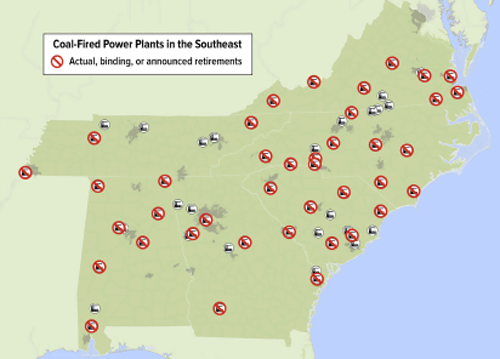The new energy trajectory in the Southeast
Cutting coal
Ten years ago, there were 246 coal-fired units generating electric power in our region, and nine more huge units were planned. Coal-fired power accounted for the South’s outsized contribution to climate change and emitted enormous amounts of soot-forming sulfur dioxide, smog-forming nitrogen dioxide, and nearly 100 percent of the mercury, arsenic, and selenium contaminating our waterways.
 Today, 126 of the existing units—a third of the total coal capacity in our six states—are slated for retirement by around 2020; most of them are already closed. And seven of the proposed units never got off the ground.
Today, 126 of the existing units—a third of the total coal capacity in our six states—are slated for retirement by around 2020; most of them are already closed. And seven of the proposed units never got off the ground.
SELC has been deeply involved in this revolution, securing plans or legally binding retirement commitments and turning aside most of the proposed new plants, while ensuring that the two that were built burn as cleanly as possible. These developments played a major role in reducing emissions from electric power generation in our region down 29 percent between 2005 and 2013—even as the population of the Southeast increased by an estimated 10 percent.
These changes have come without increasing the average home electricity bill. And despite all the rhetoric, most of our states are already well on their way to meeting their goals under the Environmental Protection Agency’s historic Clean Power Plan, the first-ever limits on electricity-sector CO2.
Much of this progress came from applying an economic principle in the courtroom. SELC figured if we could force utilities to pay the true costs of a coal-based energy system—what economists call internalizing cost—we could create powerful incentives to close coal plants.
We also had the legal expertise to make sure that coal-fired power plants included all the pollution control technology required by law and met the strictest environmental standards. By forcing the utilities to install the latest, most effective pollution controls, as required by law, we set the bar not just for new plants but for any plan to modernize old coal-fired units.
New standards for air toxics
In 2011, the new “Mercury and Air Toxics Standards” finally took effect—and was challenged by 40 coal-allied industry groups on the day it was issued, despite studies showing it would avoid more than 11,000 premature deaths every year and save $37 billion to $90 billion in annual health care costs.
Most recently, the D.C. Circuit Court of Appeals upheld the rule against industry challenges. Finally faced with the actual costs of complying with this law, utilities in our six southeastern states have shuttered 58 old, inefficient coal-fired units for which investment could not be economically justified.
Moving on to the Clean Power Plan
SELC’s work over the past decade helped lay the foundation for EPA’s historic Clean Power Plan, finalized in August of this year. The plan will produce a 32 percent reduction in carbon emissions nationwide by setting state-specific targets and is a powerful tool for maintaining the momentum of our energy progress. In the Southeast, retirement commitments already in place leave most of our states well positioned to meet the goals outlined in the plan.
We aren’t there yet, but the results so far make it clear that cleaner energy for the South isn’t some far-off dream. It’s happening right here, right now.
